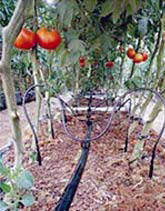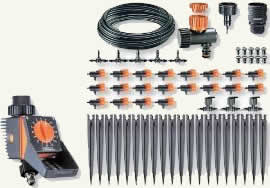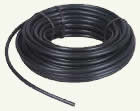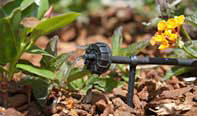Drip irrigation, as shown in Figure 1, may become the only method of watering plants, shrubs and trees in the very near future. The climate is changing, and whether or not you believe in global warming as the cause it makes little difference to the fact that drought is apparent in places that have over the past experienced heavy rainfall - Australia and California are 2 primary examples.

Figure 1 - Drip irrigation for tomato plants
With the increase in populations, our demand for clean potable water has grown and will continue to grow at staggering rates. There is just not enough fresh water to sustain us if we continue to abuse this key natural resource.
We must reduce the amount of water that we consume. Current methods of watering gardens, lawns, shrubs and trees usually wastes more water than is actually utilized. We water our driveways, fences and walkways. We over water, to the point where we leave puddles of water, which become perfect habitats for mosquitoes laden with West Nile Virus and we pay for it with hard dollars.
Drip irrigation, is economic and environmentally sound. It is a proven system for growing healthy plants.
Why Should You Use Drip Irrigation?
- dramatically lowers water usage, saving a resource
- conveniently irrigates small and irregularly shaped areas
- easy to install
- dramatically lowers water costs
- may be allowed by municipalities during times of drought
Drip irrigation and micro-sprinkler systems are extremely easy to install, even if you do not consider yourself a handyman or woman. The installation of a drip irrigation system requires a lot less effort than installing a traditional underground sprinkler system.
Individual parts and complete drip irrigation kits, as shown in Figure 2, are readily available at most home improvement, garden and landscaping centers as well as on the Internet and at most hardware stores.

Figure 2 - Drip irrigation system
How does drip irrigation work?
Unlike hand watering or using traditional sprinkler systems which have an efficiency of less than 70 percent, drip irrigation systems deliver water to each individual plant at efficiencies exceeding 90 percent, through a network of small diameter plastic tubing (Figure 3).

Figure 3 - 1/4" drip irrigation tubing
The systems provide a controlled water flow at very low pressure and flow rates.
Most drip irrigation systems are controlled by an electronically programmable distribution box, as shown in Figure 4, that provides the watering scheduled. It is similar to a programmable electronic heating and cooling thermostat that are now prevalent in most homes in order to save on heating and cooling costs.

Figure 4 - Drip irrigation timer/controller
Traditional sprinkler systems and hand watering produces shock watering to plants, because the plants are usually subjected to high fluctuations of wet and dry conditions. This situation inhibits plant growth. With drip irrigation you automatically maintain the proper proportional balance between the air and water in the soil where the plant roots are obtaining their nourishment. This promotes healthy plants and a much superior growth rate.
Commercial growers have been using drip irrigation and micro-sprinklers, as shown in Figure 5, for many years to provide proper irrigation, economically, to orchards, farms, greenhouse and nursery operations.

Figure 5 - Drip irrigation micro sprinkler head
From the commercial applications, manufacturers of drip irrigation and micro-sprinkler systems have adapted their products for use by homeowners. In home gardens, drip irrigation can be conveniently configured to provide moisture to small and large vegetable, herb and flower gardens and can easily be utilized for hanging baskets and window boxes. The use of drip irrigation for fruit trees will provide larger and faster growing fruit.
